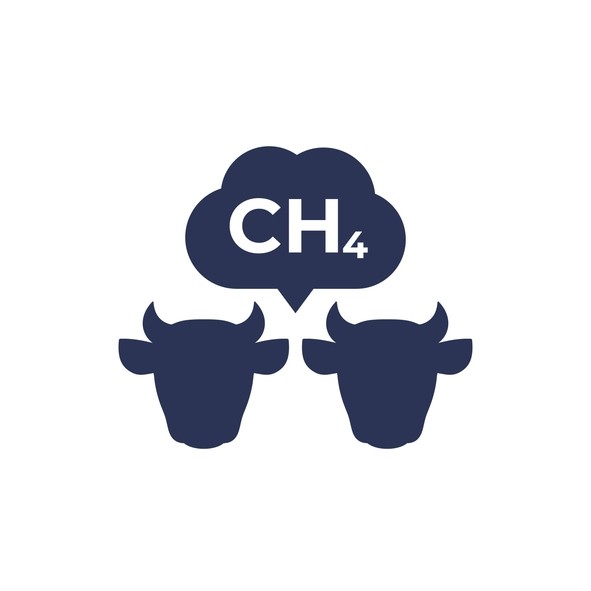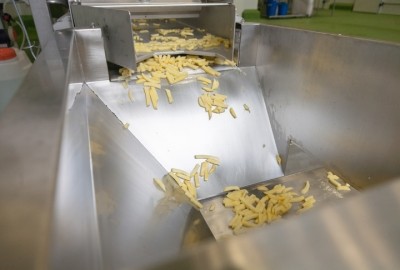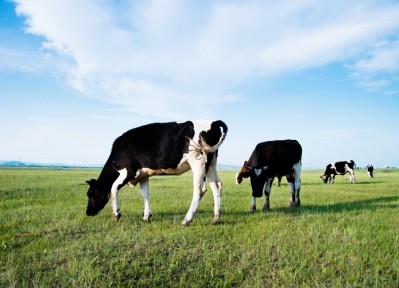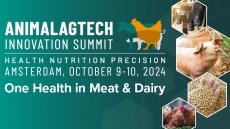How to achieve 30% cut in methane emissions from cows by 2030

That was the consensus among experts who participated in our online panel earlier this month.
The FeedNavigator webinar, titled "Cracking the Methane Code: Genetic, Feed, and Farmer Solutions for Emission Reduction by 2030," featured specialists from Europe and the US. The panelists discussed the components of an effective methane reduction toolbox, highlighting the importance of integrated strategies and support mechanisms for farmers.
Early action on methane is the path to net zero, said John Tauzel, senior director for global agriculture methane at the US headquartered, Environmental Defense Fund (EDF).
The webinar can be listend to on-demand so register today to hear those experts first-hand.
No cookie cutter solutions
There is no cookie cutter solution to mitigation of this potent gas, he said.
“If you have five different farms, you have five different solutions that can be implemented in five different ways or practices. We recognise that to address methane it will require a bespoke, tailormade approach for each farm."
Increasing productivity on farm and improving animal health will be important, but the big wins in methane emissions reduction will be achieved through optimized manure management and enteric methane mitigation approaches that target methanogens in the rumen, he remarked.
Manure management
For manure, potential solutions include capturing biogas from manure storage or preventing methane formation altogether, with solid-liquid separation being a promising method.
”It is crucial to implement manure storage systems that avoid unintended negative impacts on both the climate and the local environment.”
US policy advances
The recent approval by the US Food and Drug Administration (FDA) of Bovaer for dairy cows, a feed additive targeted at methane reduction, is an exciting development, but additional research and development are needed to bring more products to the US market, commented Tauzel.
Specifically, there should be increased focus on innovation to reduce methane emissions from beef cattle, particularly those raised on pasture.
“The Enteric Fermentation R&D Accelerator, a global initiative under the Global Methane Hub, aims to harmonize and coordinate research to expedite the introduction of solutions."
US policy advances, such as the Innovative FEED Act, will support enteric methane targeted innovation by providing the FDA with greater authority and ensuring a transparent process for bringing new products to market, he continued.
“However, it is really critical that we get the safety protocol correct,” he added.

Precision nutrition, animal health
Dr Annie Williams, business development manager at the UK Agri-Tech Centre, agreed with Tauzel that improving manure management will support methane reduction efforts.
The UK Agri-Tech Centre is exploring multiple mitigation strategies including ones based on a precision nutrition approach involving the formulation of diets with closer alignment to amino acid requirements in tandem with projects focused on reducing the amount of protein in animal diets, she explained.
The team is also assessing how to enhance forage quality, particularly with multi-species swards, with such innovation likely to play a big role in lowering carbon footprint and greenhouse gas (GHG) emissions in both grasslands and livestock production, reported Williams.
Animal-specific strategies are also crucial. These include genetic improvements for better efficiency, improving cow fertility, and reducing the age at first calving. “Enhancing animal health is vital, as healthier animals are more efficient and produce less methane per unit of product.”
Dancing with Daffodils
The UK Agri-Tech Center is actively involved in trials and projects targeting methane reduction. One such initiative is the Dancing with Daffodils project, a 48-month feasibility research study exploring the integration of a daffodil compound into ruminant rations. As daffodils are grown extensively throughout the UK, the idea is that the production and extraction of these compounds can be local, sustainable, and resilient. The initiative aims to decrease the carbon footprint of the ruminant livestock sector. A potential increase in protein utilization, leading to a decrease in soybean meal requirements per cow per day, could lessen the reliance on imported soy and make the daffodil extract cost effective.
The Center is also engaged in the Breeding for CH4ange project, led by Innovis, which looks at reducing the carbon footprint of sheep farms using a combination of genetic improvement tools and methane monitoring equipment to breed sheep that produce less methane. The project recognizes the challenges inherent in reducing methane emissions from grazing animals like sheep.
Roughage quality
Jan Dijkstra, associate professor of animal nutrition at Wageningen University (WUR), Netherlands, told us about the importance of considering the quality of roughage fed to cows, with the expert stressing the relationship between grass quality and methane emissions.
Research undertaken at WUR revealed that feeding dairy cows the youngest, most digestible grass significantly reduces methane emissions compared to feeding them more mature grass, he continued.
The WUR team found that grass silage made from shorter, leafier grass produces much less methane than silage made from grass harvested at a later stage, which becomes stiffer and less digestible. Eating young grass or young grass silage can result in up to 30% less methane emissions. “This presents an opportunity for many farmers to incorporate this strategy into their day-to-day management to reduce methane emissions,” Dijkstra reported.
Dietary impact
He also noted that there is significant variation in the effectiveness of different methane mitigation strategies.
A case in point is a meta-analysis conducted by Dijkstra and other experts on 3NOP, or Bovaer. Published last year, the study showed that the mitigating effect of this additive on methane emissions in dairy cows is influenced by the nutrient composition of the diet. Specifically, increases in fiber and crude fat concentrations reduced the effectiveness of 3NOP in mitigating methane production and yield, while increases in starch content enhanced its effectiveness. For methane intensity, reducing the fiber content of the diet improved the additive's effectiveness. As expected, increasing the dose of 3NOP resulted in greater efficacy, Dijkstra told us.
Another important point, said the ruminant nutrition expert, is that it is crucial for farmers to trust the products they use, to have assurances that they are reliable and do not negatively impact production or animal health. Equally important is consumer satisfaction with the use of mitigation agents on farms for methane reduction. So, ensuring both farmers' trust and consumers' approval is essential for the successful implementation of these solutions, he stressed.
Farmer incentives, parternships
Dr Pablo Modernel, program manager, Farm Nature, FrieslandCampina, shared with us how the dairy cooperative is encouraging emission reductions through feed additive trials and farmer incentives. But driving change throughout the whole value chain is the overarching goal for the business.
“We can make a significant impact within the dairy sector. With our 11,000 member farmers, we hold a unique position to address key sustainability themes throughout the entire supply chain, from grass to glass. These themes include carbon footprint, biodiversity, clean water and energy, better nutrition, and packaging.”
Work is in progress on emissions reduction, but acceleration is needed to reach a 33% reduction by 2030, compared to a 2015 baseline.
The cooperative supplies farmers with knowledge and tools to reduce on-farm emissions but partnerships and valorisation initiatives are also playing a role.
Various measures implemented by its farmer members to improve sustainability and earn financial bonuses include increasing cow longevity, reducing GHG emissions with feed additives, sourcing low-carbon animal feed, fermenting manure, enhancing biodiversity by growing more home-grown protein, increasing permanent grassland, and sowing herb-rich grassland. For their efforts, the farmers earn premiums through FrieslandCampina's ‘Foqus Planet Sustainable Development’ incentive system, or from participation in special milk flows such as organic, On the way to PlanetProof, and VLOG.
The cooperative has entered into agreements with key international buyers, such as Mars, McDonald’s, and Mondelēz International, to support the accelerated reduction of GHG emissions during milk production for dairy products supplied to those conglomerates; such alliances enable FrieslandCampina to remunerate its member farmers for their sustainability focused actions.

Government subsidies, blended finance
Looking beyond such funding exercises, and in April, the Danish government announced it was setting aside US$74m to finance the use of feed additives to cut methane emissions from the country's roughly 550,000 dairy cows by 30% in 2030. When asked whether such government subsidies are the way to go to encourage farmers to adopt methane reduction strategies, Williams told us:
“We’re having extensive discussions around these topics. In the UK, for example, Defra announced that by 2030, every cow would have a methane additive. However, they did not explain how they plan to implement this, particularly regarding funding. These are ongoing conversations we’re having with farmers and the entire supply chain, including processors and retailers, who need to reduce their Scope 3 emissions. Dairy products often represent a significant portion of these emissions.
“There's considerable work being done along the supply chain, with a lot of research and development in this area. Many businesses are currently trialling different additives and exploring various methods to reduce emissions, encouraging farmers to adopt these practices. While government incentives might play a role, it’s crucial to ensure we have the science and evidence to support the effectiveness of additives in specific situations, whether for TMR-fed or grazing cattle.
“Before any government incentives are implemented, we will likely see significant work within the supply chain. Ensuring that the right additive is effective in the given context is essential. This groundwork will pave the way for potential government incentives, making the transition smoother and more scientifically backed.”
Returning to the other side of the pond, and the EMIT LESS Act, recently introduced into the US House of Representatives, if enacted, would advance lower-methane livestock production, said Tauzel. It would do so by boosting financial support and training to enable more producers to adopt enteric methane solutions more quickly and by accelerating research into additional solutions.
Last year saw Elanco launch a tool, UpLook, to help US dairy farmers quantify their GHG emissions reductions; it connects to Athian, a livestock carbon inset marketplace. Tauzel also weighed in on that development, saying the approach is a promising first attempt at finding a financial instrument to advance change.
“What we really need to see in the short term is a blended finance model to cover some of the costs. This would involve private financing, public sector financing, and supply chain financing working together. We need to trial various models and processes to determine which ones farmers will actually adopt. Ultimately, multiple approaches will be necessary to bring methane mitigation solutions to market effectively.”
By experimenting with different models, stakeholders can identify the best strategies to support farmers and achieve sustainability goals, he added.
In addition to policy, improvements in monitoring, reporting and verification (MRV) systems will incentivize mitigation practices by farmers, he believes.
Dijkstra agreed: "We need to accurately quantify methane mitigation to properly reward the farmer."

















